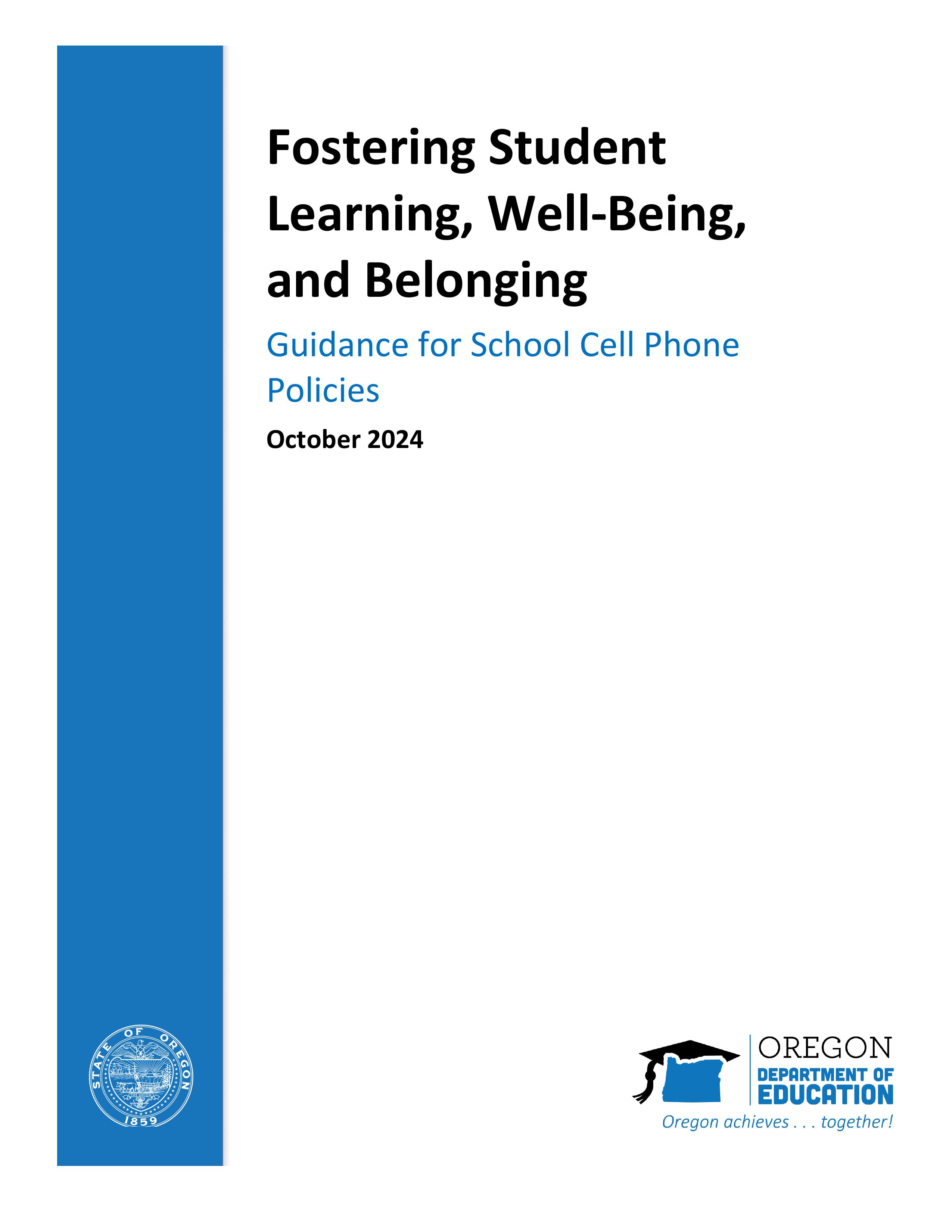The Oregon Department of Education is dedicated to creating safe and supportive educational environments for all students. Our mission is to empower students, educators, and parents with the tools and knowledge to recognize, prevent, and address bullying, harassment, intimidation and cyberbullying in schools. By fostering a culture of respect, inclusion, and empathy, we aim to ensure that every student feels valued, respected, and safe to learn and reach their greatest potential. Together, we can build a positive school climate where every student feels they belong.
Oregon law (ORS 339.351(2)) defines “harassment, intimidation, or bullying” as any act that:
Substantially interferes with a student’s educational benefits, opportunities, or performance, and;
Takes place on or immediately adjacent to school grounds, at any school-sponsored activity, on school-provided transportation, or at any official school bus stop; and has the effect of:
The law (ORS 339.351(1)) includes cyberbullying, which is defined as “the use of any electronic communication device to harass, intimidate, or bully.”
The
CDC defines bullying as “any unwanted aggressive behavior(s) by another youth or group of youths, who are not siblings or current dating partners, that involves an observed or perceived power imbalance, and is repeated multiple times or is highly likely to be repeated. These behaviors are repeated multiple times or are highly likely to be repeated.”
Bullying complaints not involving protected class, as defined within ORS 174.100 and 339.351, are handled at the local (district) level. For bullying complaints on the basis of protected class, support for students and families is available through districts’
Civil Rights Coordinators and through
ODE’s Civil Rights department. More information regarding bullying policies, requirements, and district complaint procedures can be found below in our FAQ Section.
New Resources:

 Resources:
Resources:
PSA: Bullying is Everywhere
The video below is a public service announcement from our partners at PACE about bullying and harassment in schools. This link will take you outside of the ODE website and direct you to pace.org where you will find other information and resources on bullying prevention.

Frequently Asked Questions:
Does Oregon have a state law that prohibits bullying in schools?
How is “harassment, intimidation, or bullying” defined?
Oregon law defines “harassment, intimidation, or bullying” as any act that:
- Substantially interferes with a student’s educational benefits, opportunities, or performance, and;
- Takes place on or immediately adjacent to school grounds, at any school-sponsored activity, on school-provided transportation, or at any official school bus stop; and has the effect of:
- Physically harming a student or damaging a student’s property;
- Knowingly placing a student in reasonable fear of physical harm to the student or damage to the student’s property; or
- Creating a hostile educational environment, including interfering with the psychological well-being of a student.
Does Oregon's law include cyberbullying?
Yes. The law includes cyberbullying, which is defined as “the use of any electronic communication device to harass, intimidate, or bully.”
Does Oregon law protect only certain groups from bullying?
No. Oregon law protects all students, recognizing that bullying “may be based on, but not be limited to, the protected class status of a person.”
How is “protected class” defined under Oregon law?
Oregon law defines protected class as a “group of persons distinguished, or perceived to be distinguished, by race, color, religion, sex, sexual orientation, national origin, marital status, familial status, source of income or disability.”4
HB 3041 (2021) also adds gender identity as a separate protected class.
What must public school districts do to comply with the law?
The law requires school districts to formally adopt policies that:
- Prohibit harassment, intimidation, bullying, and cyberbullying;
- Require employees to report an act of harassment, intimidation, or bullying;
- Allow students or volunteers to report harassment, intimidation, or bullying voluntarily and anonymously;
- Create a uniform procedure for reporting harassment, intimidation, or bullying;
- Create a process that the district will follow in investigating a report of harassment, intimidation, or bullying. This process must:
- Identify by job title the school officials responsible for receiving and investigating reports of harassment, intimidation, or bullying;
- Identify a procedure by which a person may request a school district to review the actions of a school in responding to a report of harassment, intimidation, or bullying;
- Include a statement of the consequences and remedial action for a person found to have committed an act of harassment, intimidation, or bullying;
- Prohibit retaliation against any person who reports an act of harassment, intimidation, or bullying; and,
- Identify corrective action for one who falsely accuses another of harassment, intimidation, or bullying.
What additional steps must public school districts take in their school district policies beginning in July 2021 to comply with HB 2631?
School districts must include notification requirements in their policy prohibiting harassment, intimidation, or bullying, and prohibiting cyberbullying.
When Notification IS Required:
- Beginning July 1, 2021, the law requires the school official responsible for receiving and investigating reports of harassment, intimidation, or bullying, or act(s) of cyberbullying to:
- Notify the parents or guardians of a student who was subjected to an act of harassment, intimidation, or bullying, or an act of cyberbullying.
- Notify the parents or guardians of a student who may have committed an act of harassment, intimidation or bullying, or an act of cyberbullying.
- Notification must occur with involvement and consideration of the needs and concerns of the student who was subjected to an act of harassment, intimidation or bullying, or an act of cyberbullying.
- The school official must inform the student of the determination to notify the parents or guardians prior to providing notification.
- The notification must occur promptly for acts that caused physical harm to the student; otherwise, notification must occur within a reasonable period of time.
When Notification IS NOT Required:
- When Notification IS NOT Required: Notification is not required if:
- The school official reasonably believes notification could endanger the student who was subjected to harassment, intimidation, or bullying, or an act of cyberbullying; or
- If all three of the following occur:
- The student who was subjected to harassment, intimidation, or bullying, or an act of cyberbullying requests that notification not be provided to the student’s parents or guardians;
- The school official determines that notification is not in the best interest of the student who was subjected to an act of harassment, intimidation, or bullying, or an act of cyberbullying; and
- The school official informs the student that federal law may require the student’s parents or guardians to have access to the student’s education record, including any requests made regarding notification.
How do I find my district’s anti-bullying policy?
The law requires districts to make their policy “readily available . . . at each school office or at the school district office, and if available, on the website for a school or the school district.”
How does one report a concern regarding bullying?
Each school district has a process for filing a bullying complaint. A written, dated complaint with specific facts is the best method. Review the school district’s process carefully and ask questions of school district office personnel about the method for filing a complaint. Be as objective and specific as possible so that a thorough investigation can be conducted.
What if I file a report and am not satisfied with the school’s response?
The law requires school district policy to allow for an appeal at the district level if you are not satisfied with a school’s response to a report of bullying. Follow the procedures written in the district policy for requesting the district to review the actions of the school. Pay close attention to review deadlines.7
Are there federal laws that protect against harassment, intimidation, and bullying?
Depending upon the unique facts and circumstances of a situation, there are federal laws that apply to certain protected classes in cases involving harassment, intimidation, or bullying. These include Title VI of the Civil Rights Act, Title IX of the Education Amendments Act, Section 504 of the Rehabilitation Act, Title II of the Americans with Disabilities Act Amendments Act, and the Individuals with Disabilities Education Act.8 A discussion of these laws is beyond the scope of this guidance document. However, more information is available at the following locations:
Other Resources